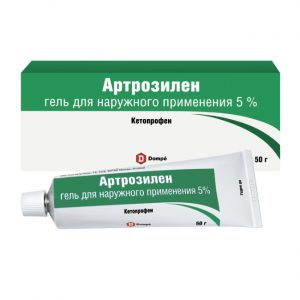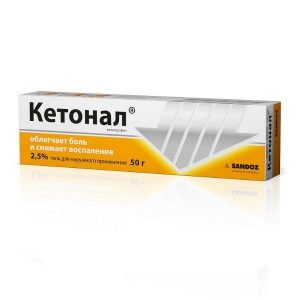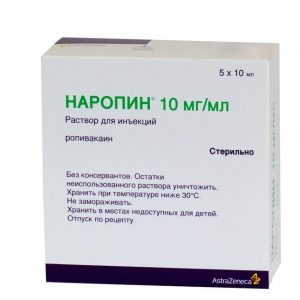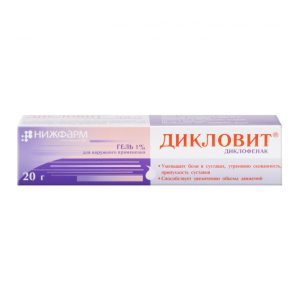Description
Release form
film-coated tablets.
Packaging
10 vials of 50 ml.
Pharmacological action
Pharmacotherapeutic group non-steroidal anti-inflammatory drug (NSAIDs) and analgesic non-narcotic drug.
ATX code: M01AE51.
Pharmacological properties of
Combined drug. It has analgesic, anti-inflammatory and antipyretic effects. The mechanism of anti-inflammatory action of ibuprofen is due to the inhibition of the activity of cyclogenases (COX) with subsequent suppression of prostaglandin synthesis.
Paracetamol is a non-narcotic analgesic that blocks COX mainly in the central nervous system, acting on the centers of pain and thermoregulation, has an analgesic and antipyretic effect.
Pharmacokinetics
Ibuprofen is well absorbed from the stomach. Tmax – about 1 hour. Absorption decreases slightly when taking the drug after a meal. About 99% binds to plasma proteins. Ibuprofen is slowly distributed in the synovial fluid and excreted from it more slowly than from plasma. It undergoes metabolism in the liver, mainly by hydroxylation and carboxylation of the isobutyl group. The isoenzyme of CYP2C9 takes part in the metabolism of the drug. After absorption, about 60% of the pharmacologically inactive R-form of ibuprofen slowly transforms into the active S-form. Has a two-phase elimination kinetics. The half-life (T ) From plasma is 2-3 hours. Up to 90% of the dose can be detected in the urine in the form of metabolites and their conjugates. Less than 1% is excreted unchanged in urine and, to a lesser extent, with bile. Ibuprofen is completely excreted in 24 hours.
Paracetamol is rapidly absorbed from the digestive tract. The time to reach C max in 0.5-2 hours. Evenly distributed in body fluids. Communication with plasma proteins is variable within 15%. Penetrates through the BBB. It is metabolized in the liver (90-95%): 80% undergoes a conjugation reaction with glucuronic acid and sulfates to form inactive metabolites 17% undergoes hydroxylation with the formation of 8 active metabolites, which form inactive metabolites upon conjugation with glutathione. With a lack of glutathione, these metabolites can block the hepatocyte enzyme systems and cause their necrosis. The isoenzyme of CYP2E1 is involved in the metabolism of paracetamol. T 1/2 1-4 hours. It is excreted by the kidneys in the form of conjugates, and only 3% unchanged. In elderly patients, paracetamol clearance decreases and T1 / 2 increases.
Indications
Fever in acute respiratory infections, flu, post-vaccination reactions and other infectious and inflammatory diseases.
Pain of mild or moderate intensity, including: headache and toothache, migraine, neuralgia, lumbago, myalgia, fibrositis, tendovaginitis, arthralgia with rheumatoid arthritis, osteoarthrosis, gout, spondylitis, etc., pain in diseases of ENT organ, with injuries of soft tissues and musculoskeletal system (sprains, bruises, dislocations, fractures, etc.), postoperative pain, algomenorrhea.
Contraindications
Hypersensitivity to ibuprofen, paracetamol, acetylsalicylic acid or other NSAIDs, as well as other components of the
drug Indication of a history of bronchial obstruction, urticaria, rhinitis, provoked by the use of acetylsalicylic acid (salicylates) or other NSAIDs (complete or incomplete intolerance to acetylsyl salicylic acid nasal mucosa, bronchial asthma).
Period after coronary artery bypass grafting
Erosive-ulcerative lesion of the gastrointestinal tract, active gastric bleeding
Inflammatory bowel disease
Hypocoagulation, cerebrovascular bleeding
Severe renal and / or hepatic insufficiency, confirmed hypertension lactation period
Children under 12 years of age (this dosage form)
Caution: congestive heart failure, arterial hypertension, coronary heart disease, cerebrovascular disease, dyslipidemia, diabetes mellitus, peripheral arterial disease, smoking, frequent alcohol use, hyperbilirubinemia, liver cirrhosis with portal hypertension, hepatic and / or renal failure, nephrotic syndrome, pregnancy I and II trimesters, advanced age, glucose-6-phosphate dehydrogenase deficiency, ulcers ennaya ulcer and 12 duodenal ulcer (disorder), gastritis, blood disease of unknown etiology (leukopenia and anemia).
Use during pregnancy and lactation
The drug is contraindicated in the III trimester of pregnancy. Application in the I and II trimester, the period of lactation should be discussed with the attending physician.
Special instructions
Treatment with the drug should be carried out in the minimum effective dose, the shortest possible short course.
During treatment, it is necessary to control the picture of peripheral blood and the functional state of the liver and kidneys. When symptoms of gastropathy appear, careful monitoring is indicated, including esophagogastroduodenoscopy, a blood test with hemoglobin, hematocrit, and stool analysis for occult blood .. To prevent the development of NSAIDs, gastropathy is recommended to be combined with prostaglandin E preparations (misoprostol) .. Patients should refrain from all types activities requiring increased attention, rapid mental and motor reactions. During the treatment, alcohol (ethanol) is not recommended.
When taken concomitantly with indirect anticoagulants, it is necessary to control the blood coagulation system.
Composition of
Each tablet contains: Active ingredients: Ibuprofen 400 mg
Paracetamol 325 mg
Excipients: Calcium hydrogen phosphate 20.995 mg, corn starch 88.005 mg, povidone K306,000 mg, talcum powder coated 10,000 srd 06G53189) (hypromellose 5 cp 29.500%, hypromellose 15 cp 29.500%, titanium dioxide 22.833%, dye sun sunset yellow 6.667%, macrogol 6000 5.500%, propylene glycol 5.500%, sodium lauryl sulfate 0.500%) 15,000 mg.
Dosage and administration of
The drug is taken orally after a meal.
Adults and children over 15 years of age: the drug is taken 1 tablet 3-4 times a day with an interval of 6-8 hours (no more than 4 times a day!).
Children from 12 to 15 years old (body weight over 40 kg): 1 tablet 3 times a day.
If the fever persists for more than 3 days, consult a doctor.
The duration of treatment is determined by the doctor depending on the therapeutic effect and the nature of the disease.
Active ingredient srdlklpprp01 rare siblocrpfut the following side effects may occur: Gastrointestinal tract: NSAIDs gastropathy (nausea, vomiting, heartburn, abdominal pain, constipation, flatulence, decreased appetite, rarely – ulceration of the joints gastrointestinal tract, in some cases complicated by bleeding and perforation), irritation or dryness of the oral mucosa, pain in the mouth, ulceration of the gum mucosa,
Hepatobiliary system: hepatitis
Allergic reactions: skin rash (usually erythematous or urticaria), skin itching, Quincke’s edema, anaphylactoid bronchitis, anaphylactoid ankylosing spondylitis, anaphylactoid anemia, or dyspnea, fever, erythema multiforme exudative (including Stevens-Johnson syndrome), toxic epidermal necrolysis (Lyell’s syndrome), eosinophilia, allergic rhinitis.
Cardiovascular system: heart failure, tachycardia, increased blood pressure.
Central and peripheral nervous system: headache, dizziness, insomnia, anxiety, nervousness and irritability, psychomotor agitation, drowsiness, depression, confusion, hallucinations, rarely – aseptic meningitis (more often in patients with autoimmune diseases)
Hematopoietic organs: anemia (including hemolytic, aplastic), thrombocytopenia and thrombocytopenic purpura, agranulocytosis, leukopenia.
Respiratory system: shortness of breath, bronchospasm.
Sensory organs: hearing impairment (ringing or tinnitus), visual impairment (toxic optic neuritis, blurred vision or diplopia, dry and irritated eyes, conjunctival edema and eyelids of allergic origin, scotoma)
Urinary system: acute renal failure, allergic nephritis, nephrotic syndrome (edema), polyuria,
cystitis Laboratory indicators: bleeding time, serum creatinine concentration, activity of hepatic “transaminases” (serum glucose concentration may increase), irens creatinine, hemotocrit or hemoglobin (may decrease).
Drug Interactions
Microsomal oxidation inducers (phenytoin, ethanol, barbiturates, rifampicin, phenylbutazone, tricyclic antidepressants) increase the production of hydroxylated active metabolites, increasing the risk of severe hepatotoxic reactions.
Microsomal oxidation inhibitors reduce the risk of hepatotoxicity.
Reduces hypotensive activity of vasodilators (including slow calcium channel blockers and ACE inhibitors), natriuric and diuretic furosemide and hydrochlorothiazide .. Reduces the effectiveness of uricosuric drugs, enhances the effect of indirect anticoagulants, antiplatelet agents fibrinolytics (increased risk of hemorrhagic complications), ulcerogenic effect with bleeding of glucocorticosteroids, colchicine, estrogens, ethanol enhances the effect of oral hypoglycemic drugs and insulin.
Antacids and colestyramine reduce the absorption of ibuprofen .. Increases the blood concentration of digoxin, lithium and methotrexate
Caffeine enhances the analgesic effect.
With the simultaneous administration of the active component of Brustan – ibuprofen reduces the anti-inflammatory and antiplatelet effect of acetylsalicylic acid (ASA) (after the start of ibuprofen intake, it is possible to increase the incidence of acute coronary insufficiency in patients receiving small doses of ASA as an antiplatelet agent).
When given with anticoagulants and thrombolytic drugs (alteplase, streptokinase, urokinase), serotonin reuptake inhibitors (citalopram, fluoxetine, paroxetine, sertraline), the risk of developing serious gastrointestinal bleeding increases.
Cefamandol, cefaperazone, cefotetan, valproic acid, plicamycin increase the incidence of hypoprothrombinemia.
Myelotoxic drugs enhance the hematotoxicity of the drug.
Cyclosporine and gold preparations enhance the effect of ibuprofen on the synthesis of prostaglandins in the kidneys, which is manifested by an increase in nephrotoxicity. Ibuprofen increases the plasma concentration of cyclosporin and the likelihood of developing its hepatotoxic effects .. Medicines that block tubular secretion, reduce excretion and increase the plasma concentration of ibuprofen.
Overdose
Overdose problems occur very rarely, however, with an accidental overdose, you should consult your doctor immediately.
Symptoms: abdominal pain, nausea, vomiting, headache, tinnitus, metabolic acidosis, coma, acute renal failure, decreased blood pressure, bradycardia, tachycardia.
A hepatotoxic effect may occur with the development of paracetamol-related hepatonecrosis.
Treatment: gastric lavage (only within one hour after ingestion), activated charcoal, alkaline drink, forced diuresis, introduction of SH-group donors and precursors for the synthesis of glutathione – methionine and N-acetylcysteine. The need for additional therapeutic measures (further administration of methionine, in / in the introduction of N-acetylcysteine) is determined depending on the concentration of paracetamol in the blood, as well as the time elapsed after its administration. Symptomatic therapy is also shown.
Storage conditions
Store in a dry, dark place at a temperature not exceeding 25 ° C. Keep out of reach of children.
Shelf life
3 years.
Active ingredient
Ibuprofen, Paracetamol
dosage form
tablets
Prescription
Appointment
Pregnant I and II trimester as prescribed by a doctor, Children over 12 years old, for adults, For children prescribed by a doctor
Pyer Fabre Medicament France pyrénée Francepérique férière férieur France francefrieaf fridayfrance oratoriz Limited, India




